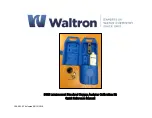
- 9 -
4.3.3
The 3
rd
point calibration
Repeat the steps as per Section 4.3.2, use pH10.01 buffer solution, and complete the 3
rd
point
calibration. The bottom left of LCD indicates .
4.4
Sample test
Rinse pH electrode in distilled or deionized water, allow it to dry, and submerge it in the sample
solution. Stir the solution briefly and allow it to stay in the sample until the value becomes stable
and icon appears on LCD, get the reading which is the pH value of the sample solution.
4.5
Information regarding pH calibration and measurement
4.5.1
During the process of calibration and measurement, submerge both the pH electrode and
the temperature probe into the solution to ensure automatic temperature compensation.
4.5.2
In calibration mode, press to exit.
4.5.3
The meter can conduct 1~3 points of calibration according to measurement requirements.
Refer to Table - 3 to check when to adopt.
4.5.4
During the process of calibration and measurement, the meter has self-diagnosis functions,
indicating information Er1~Er4, please refer to Table - 4 for relevant solutions.
4.5.5
The calibration frequency depends on the sample, electrode performance and accuracy
requirement. For high accuracy measurements (≤±0.03pH), the meter should be calibrated before
testing every day. For ordinary accuracy measurements (≤±0.1pH), once calibrated, the meter can
be used for about a week or even longer.
In the following cases, the meter must be re-calibrated:
a)
The electrode hasn’t been used for a long time or the electrode is brand new.
b)
After measuring strong acid (pH<2) or strong base (pH>12) solutions.
c)
After measuring fluoride-containing solution and strong organic solution.
d)
There is a big difference between the temperature of the test sample and the temperature
of the buffer solution that is used in the last calibration.
4.5.6
pH temperature principle
Please note that the closer the temperature of the sample is to the calibration solution, the more
accurate will be the readings.











































